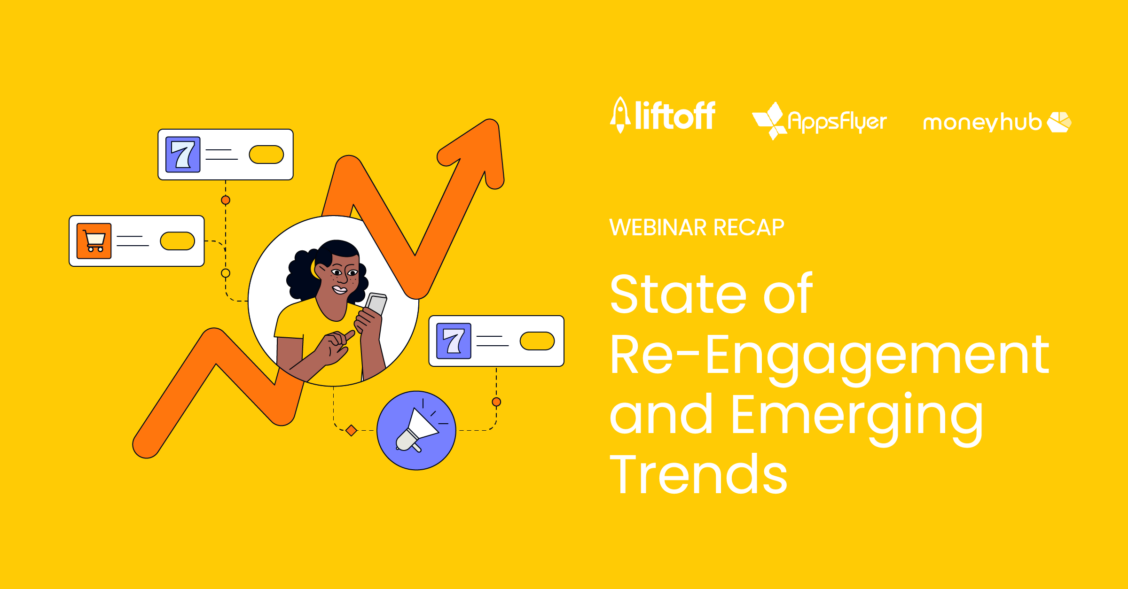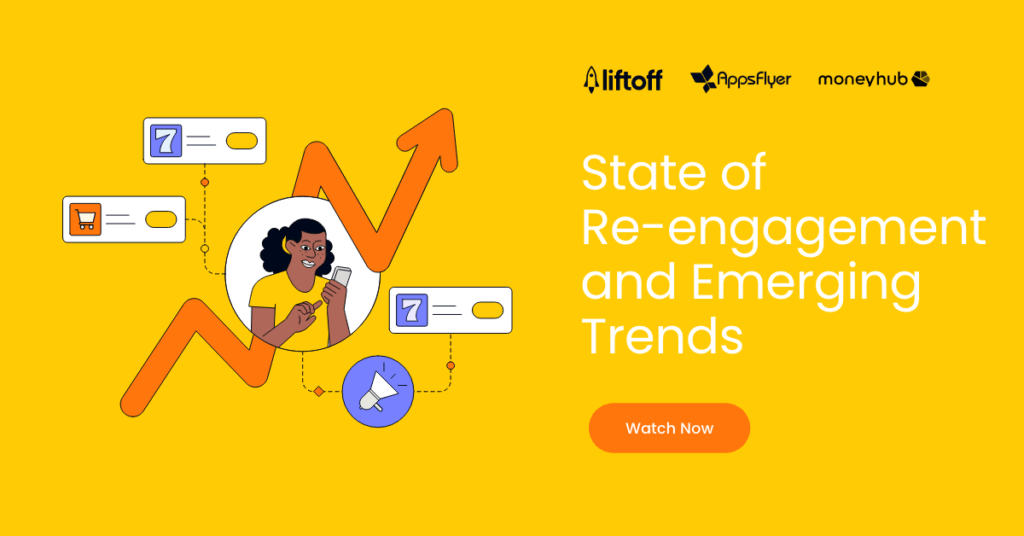
10 Key Takeaways From Our State of Re-Engagement and Emerging Trends Webinar
In our recent State of Re-engagement and Emerging Trends webinar, Liftoff Sales Engineering Manager Jackie Nguyen was joined by Mobile Hero Iain Russell, Head of Performance Marketing at Moneyhub, and Niv Klein, Product Team Lead at AppsFlyer, to discuss the evolving landscape of re-engagement for Android and iOS.
During this session, they covered several important topics, including strategies for Android and the impact of ATT on iOS re-engagement. We also explored unified UA and re-engagement setups and tailored approaches specifically designed for non-gaming apps. If you missed it, you can catch the full webinar here, but if you’re short on time, we’ve also picked out 10 key takeaways. Let’s jump in.
1: We’ve mostly recovered from the rollout of ATT
Klein has been paying close attention to advertisers’ behavior post-ATT (App Tracking Transparency) during their time at AppsFlyer and has seen some surprising results. One notable change is more advertisers are retargeting today than before ATT’s launch three years ago.
This wasn’t the case initially—right after the change happened, re-engagement saw a significant drop, but it has steadily recovered and begun to increase. Before ATT, Klein recorded that re-engagement was around 36%, but it’s now at about 39%. This may be related to Apple’s improvements to attribution, with iOS now offering multiple ways to measure the impact of campaigns.
It’s a similar story when it comes to user acquisition. After the introduction of ATT, conversions resulting from ads shown to new users fell by a massive 70%. Since then, the market has mostly recovered, with AppsFlyer data showing that, as a whole, we’re at around 70% of what we were previously. Certain verticals have also shown an improvement in conversions, such as gaming, which is now around 122% of what it was before ATT.
2. Users are willing to share their data
The biggest challenge ATT introduced was user consent. Previously, advertisers were free to target any user who visited their app, whereas now, they have to ask users for permission before accessing their data. This can be a hard sell: many users will find it intimidating being asked to allow an app they just downloaded to analyze their behavior and track them across apps and websites.
Surprisingly, though, many users are willing to do this, with Klein’s data showing that around 50% of users opt-in when prompted. Klein pointed out that some apps have implemented extra steps to encourage users to consent, like showing an introductory pop-up before the ATT prompt that clarifies its purpose. However, they did note that certain users will never opt in because their devices have been limited, such as in cases where parental permissions are in place.
3. Advertisers should enable reattribution on their UA campaigns
Before ATT, device identifiers weren’t just used for targeting—they were also used for exclusion. Ad platforms running large-scale UA campaigns used to receive lists of users who already had their app. These lists meant that even if an algorithm suggested an existing user was a prime candidate for an ad, that user could be excluded to align with the campaign’s acquisition-only goal.
However, following ATT, it’s much more challenging for ad platforms to identify who already has their app. During the webinar, Klein said that a good way to overcome this is to measure performance and take one of two actions: if the campaign is performing well, incorporate re-engagement, as it could positively impact the bottom line. If trends indicate that targeting is off, at least you’ll have visibility on what’s working and what isn’t. For example, you might discover that one targeting method brings back more lapsed users than another.
4. Get ahead of the AdAttributionKit by partnering with an MMP
One of the big reveals from WWDC 24 earlier this year was that Apple appears to have replaced its SkAdNetwork (or SKAN 5) in favor of the AdAttributionKit. The announcement caught the eye of performance marketers, as the new framework includes the ability to track conversions from ads clicked by users who have already installed the app. The only catch is that this feature is only available in iOS 17.4 and above. Thankfully, there are a few things marketers can do right now to start improving re-engagement.
Russell said that one of those is having a mobile measure partner (MMP) in place, which you can refer back to as an independent source of information. Most MMPs will also collate your information into a cohesive dashboard to help you better understand the success of your campaigns. So, say you had an advertising campaign with Liftoff. You could use an MMP to see all the signals in one place, alter them where needed, and understand the total impact of your marketing over a single campaign or even specific partners.
5. Prize draws are a great engagement strategy
If you’re looking for ways to boost engagement more generally, one strategy Russell has found to be really effective is running a monthly prize draw that users enter in one of two ways.
One is to simply be active in the app, so encouraging users to do whatever they would normally do—whether that’s playing a level in a mobile game, swiping through profiles in a dating app, recording a run in a fitness app, you name it. Two is for users to also have an active connection, such as to another account (like social media) or related app.
At the end of the month, the entries are picked at random to identify the winner who takes home the prize (this could be cash or something you know appeals to your specific audience). Knowing there’s a chance to win something keeps the app at the top of users’ minds and pushes them to keep interacting with your app.
6. Identify the best time to reactive lapsed users
Another helpful piece of advice is to consider building your strategy around reactivating inactive users. Klein mentioned that nearly every app has a “magic number”—the specific number of days after which a user is least likely to return to the app, which can be gauged through a simple analysis. Once you know the “magic number,” targeting this specific group with dedicated campaigns can help extend your user’s lifecycle.
If you were to take grocery shopping apps as an example, most users will probably use them around once a week. That would mean that if you get a user who hasn’t logged in for around eight or nine days, there’s a good chance that they might never return. However, if you were to reach them at that point with a small discount or special promotion, you might pull them back in.
Advertisers may also want to focus on the onboarding process, which involves getting users to make their first purchase or subscription. The best place to start is by looking at what signals a “good” user early on, which might include viewing multiple product pages, checking the pricing plan, or engaging without immediately leaving. After these actions, you can give users time to convert on their own.
7. Look at in-app events and custom product pages
Russell felt two key areas related to re-engagement should be more utilized on iOS: in-app events and custom product pages. Both have the option to be specifically targeted to existing users browsing the App Store. If you have someone who downloaded your app but has not used it for a while, you can reach out and let them know about new features and improvements.
At the moment, both in-app events and custom product pages are easy to use and completely free, so there’s no reason to hesitate. However, given that Apple surely must want to get more apps using these tools and populating the App Store with different graphics and visual styles, there’s a good chance that at some point these will become part of Apple Search Ads.
8. Use CRM tools to balance re-engagement campaigns
Creating any mobile marketing campaign is always a tricky balancing act. Push the user too hard, and you run the risk of them dismissing your app completely. Push the user too little, and you might just miss out on a conversion. But according to MoneyHub’s Russell, it doesn’t have to be such a challenge—practically any decent CRM tool should be able to stop a campaign from becoming too intrusive.
He said: “I’ve set up global rules to maintain a balanced communication strategy. For example, I ensure that no more than one marketing push notification is sent out within a 48-hour period and no more than three emails are sent within a week. I understand what’s acceptable can vary across products and industries, but with a finance app, where sensitive information is involved, this balance works best for us.”
9. Advertisers measure the impact of re-engagement using incrementality
It’s not enough just to have a successful app—you need to be able to demonstrably prove that it’s a result of your ad campaigns. However, measuring the impact of re-engagement can be challenging—how can you say for sure whether or not someone wouldn’t have reopened the app anyway if you’d just waited?
That’s where incrementality comes in, essentially a test versus control experiment. First, you take an audience that has been inactive for a notable period of time and should be targeted with a re-engagement campaign. But before you hit the launch button, you split said group into two. One part will be exposed to the ads, while the other will be left alone. By comparing the performance of each group, you’ll see the actual causal impact of the campaign.
Obviously, that’s a lot of work, and for many years, this privilege has been afforded only to large companies with the capacity to manage it. However, today, it’s much easier for anyone to look at incrementality due to advancements in technology offered by mobile analytics providers like AppsFlyer. These platforms make it pretty easy to run a couple of tests, understand the impact, and optimize for incremental value.
10. What’s next for Google Privacy Sandbox
Just as mobile marketers recover from Apple’s changes to the mobile marketing landscape, Google seems close behind. That being said, precisely what those changes will look like is up in the air. Earlier this year, the company announced its intentions to reverse its cookie deprecation plans, leading many to wonder what that might mean for the far more complicated Privacy Sandbox.
If you’re concerned about running into the same scramble brought about by ATT, the best thing to do is put some preparations in place. Do any of Google’s current announcements present any opportunities for you or even any risks you may need to implement? Do you know what changes you need to make if your Google advertising ID goes away? It would be worthwhile having the answers to these questions sooner rather than later.

